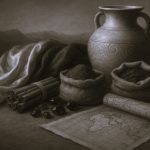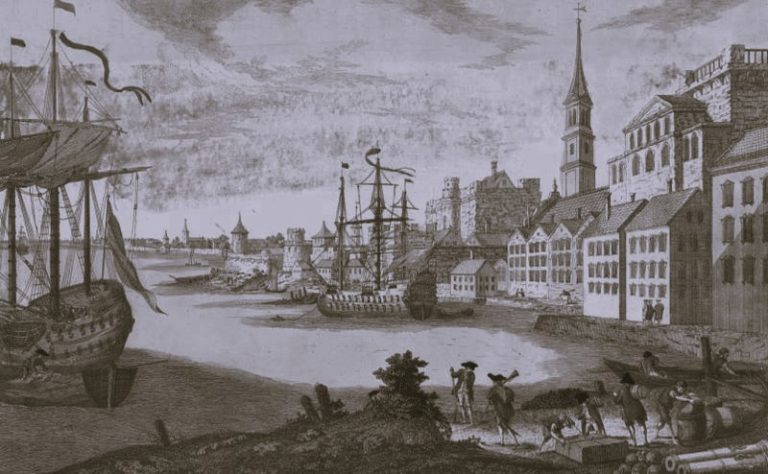

Originally published by Newberry Digital Collections for the Classroom, 11.13.2018, Newberry Library, republished with permission for educational, non-commercial purposes.
Introduction
When William Shakespeare first staged his Roman tragedies Julius Caesar (1599) and Coriolanus (c. 1608), he did not introduce his audience to new stories. Rather, he reworked characters and events with which most of his audience would have been familiar. For many people in Renaissance England, the ancient Roman republic did not seem remote or exotic. Instead, it served as an important precedent in politics and history, one which had bearing on events and people in Britain.
The similarities between seventeenth-century England and classical Rome may not be obvious to twenty-first-century readers. The English were governed by a monarch, or individual ruler, and had been for as long as people could remember. The Roman republic was founded in 509 BCE with the overthrow of the Etruscan king, Tarquin the Proud, and the rebels’ oath to make the people free of tyranny. The republican government, which lasted for almost 500 years, included three principal institutions: the Senate (300 members of the aristocracy who held life-long posts); the tribunes of the people (two powerful officials who represented the poor citizens, or plebeians); and the consuls (two men elected by the Senate and approved by the plebeians). During the republic’s final decades, there was also a dictator, the position that Julius Caesar held at the time of his assassination.
Yet these differences in political structure are not quite as firm as they appear. As the scholar Oliver Arnold explains, “England was a ‘mixed-estate’ rather than an absolute monarchy.” The monarch had to obtain the consent of Parliament, including the House of Lords and the House of Commons, in order “to levy certain kinds of taxes and enact certain kinds of law.” Early modern writers frequently compared the English Parliament to the Roman republic’s Senate and popular tribunate. The English were also mindful of Rome’s role in their early history: Julius Caesar successfully invaded Britain in 54 BCE and the Roman Empire, which succeeded the republic, controlled Britain from 77 to 407 CE. At the broader level of political culture, English people strongly identified themselves as “free” in ways that (they believed) citizens of the Roman republic had been and others in Europe were not. They accepted that they were subject to a monarch, but they drew a distinction between the just ruler and the tyrant.
Shakespeare’s representations of rebellion in classical Rome also resonated with political turmoil in the England in which he lived. Henry VIII had established the Church of England, and made himself head, in 1534. In the century that followed, Catholic conspirators repeatedly tried—or were accused of trying—to regain control of the crown, while Protestant rulers worked to consolidate the national Church of England. Elizabeth I, who ruled Britain from 1558 to 1603, thwarted numerous attempts to depose her and install Mary, Queen of Scots, as the ruler of England. Even in her final years, Elizabeth faced a small (nonreligious) insurrection led by her former favorite, the Earl of Essex. Because Elizabeth had no heirs, the question of who would succeed her was the source of considerable anxiety and political jockeying at the turn of the century. When James I assumed the throne in 1603, he alleged three major plots to overthrow him in just the first three years of his reign.
Shakespeare’s Romans may not speak to Christian religious conflicts, but they certainly raise questions about the consequences of political overthrow, the motives of conspirators, the effects of charismatic individual leadership, the obligations of virtuous citizenship, and the roles of the people and the aristocracy in government. In short, Julius Caesar and Coriolanus explore issues that would have resonated strongly with Shakespeare’s contemporaries. The documents that follow develop the context for Shakespeare’s Roman plays. They include excerpts from his primary source on classical Rome, representations of Rome by other Renaissance writers, and, finally, interpretations of Shakespeare’s characters by artists from later centuries.
Shakespeare’s Sources

Plutarch was a Greek writer who lived from approximately 46–120 CE. His most influential work traces the biographies and moral characters of famous Greeks and Romans. Latin editions of this work, known as Parallel Lives or Plutarch’s Lives, were published in Europe during the 1400s. The French writer Jacques Amyot translated it into French in the 1560s, and Thomas North translated this version into English in 1579, when it was published in London.

North’s translation was enormously influential at the time and is considered in itself a significant work of sixteenth-century English literature. It was Shakespeare’s primary source for his Roman plays, Julius Caesar, Antony and Cleopatra, and Coriolanus. The passages were taken from Plutarch and North’s accounts of the lives of Coriolanus and Mark Antony (Antonius), who led the people against Julius Caesar’s assassins.
The Geography of Ancient Rome

Abraham Ortelius was a sixteenth-century Flemish scholar and geographer who lived in Antwerp, a city in present-day Belgium. He embarked on a project to gather together the collected knowledge of sixteenth-century cartography and, in 1570, published the first modern world atlas Theatrum orbis terrarium, or “The Theater of the Whole World.” This first edition included 70 maps, each accompanied by a page of explanatory text, as well as the names of the 33 cartographers and 87 geographers whose work Ortelius had consulted. The atlas was an immediate success, praised by scholars and kings throughout Europe. It was translated from its original Latin into the major vernacular, or spoken, languages of Europe. Thirty-four editions were published from 1570 to 1612, often with the addition of new maps and references.

The English edition was printed in London in 1606. While many of the Theatrum maps portrayed the contemporary world, some were historical. The map reproduced here represents the ancient Roman Empire. A translation of the Latin text of the lower left cartouche appears with the map, below. The upper left cartouche portrays the Roman poet, Tibullus, with the quote, “Rome, your race is destined to rule the world.” The upper right cartouche portrays Romulus, the founder of Rome. The genealogical tree on the lower right shows the seven Roman kings who ruled until the founding of the republic. The kings’ names appear in the central line of double circles with Romulus at the top and Tarquin the Proud (Tarquinius Superbus) at the bottom. Their wives and children are represented by the lesser lines and circles along the sides.
Classical Rome and Renaissance England

Sir Thomas Smith was a political and legal theorist as well as a member of Parliament in the mid-sixteenth century. His De Republica Anglorum, or “Of the English Republic,” was published in 1583, posthumously, or after his death. The scholar Oliver Arnold notes that the “treatise quickly became one of the most important and frequently invoked accounts of English political and legal institutions.” Throughout the work, Smith refers to classical Rome—as opposed to other European countries—in order to describe English institutions. In the first chapter, Smith identifies three kinds of commonwealth: monarchy (rule by an individual); aristocracy (rule by a small number); and democracy (rule by the “multitude”). In the passages reproduced below, Smith distinguishes between just and unjust rulers in all three forms of government and considers whether it may ever be right for citizens to overthrow their rulers. Samuel Daniel was a respected poet and playwright whose works influenced Shakespeare.

His long poem, The Civile Wars, offers a history of the War of the Roses, the conflict between the English dynasties of Lancaster and York between 1455 and 1485. In the passages reproduced below, Daniel compares the Battle of Towton, which the Yorkist army won, to Julius Caesar’s defeat of Pompey at Pharsalus in 48 BC. (Pompey was allied with Cato and the Senate.) In this passage, the poet is addressing his muse. Together, these works by Smith and Daniel suggest how profoundly Renaissance understandings of Roman history informed English writers’ sense of their own nation’s history and identity.
Imagining Shakespeare’s Romans

These illustrations of scenes from Shakespeare’s Julius Caesar and Coriolanus were published in the late eighteenth and early nineteenth centuries, long after Shakespeare’s death. They offer insight into the significance of these plays for later audiences. The first two engravings (above and below) and title pages appear in Bell’s Edition of Shakespeare’s Plays, an elaborate nine-volume set of Shakespeare’s plays that was published in London.

In the introduction to Julius Caesar, the editor John Bell praises the play for addressing “the spirit of Liberty” and “the love of our country,” and expresses the wish that modern “Senators” (i.e., members of Parliament) would read it annually. Bell writes less favorably of Coriolanus, suggesting that the protagonist’s heroism is “of a rather savage kind” that “does not touch the heart.”

The representation of Act V, scene iii (above), in Coriolanus is part of a later collection of large illustrations of scenes from Shakespeare’s plays. The London printer and engraver, John Boydell, commissioned artists to create paintings of the scenes, which he then reproduced as engravings and published together with the plays in 1803.
Selected Sources
- Arnold, Oliver O. “Chronology” and “Republicanism, Popular Politics, and the Rhetoric of Liberty in 1599.” In Julius Caesar, by William Shakespeare. Upper Saddle River, NJ: Pearson Education, 2010. xlv-liv, 160–181.
- Bliss, Lee. “Introduction.” In Coriolanus, by William Shakespeare. Cambridge, UK: Cambridge University Press, 2000. 27–41.
- Karrow, Robert W. Mapmakers of the Sixteenth Century and Their Maps: Bio-Bibliographies of the Cartographers of Abraham Ortelius, 1570: Based on Leo Bagrow’s a. Ortelii Catalogus Cartographorum. Chicago: Speculum Orbis Press, 1993.
- Koks, Frans. “Ortelius Atlas.” Library of Congress. http://memory.loc.gov/ammem/gmdhtml/gnrlort.html.
By Dr. Hana Layson
Manager of School and Educator Programs
Portland Art Museum
By Dr. Amelia Zurcher
Associate Professor of English
Marquette University






